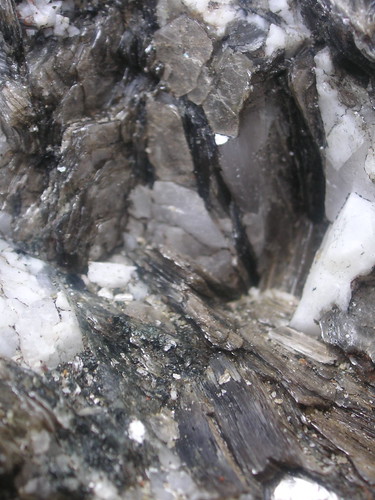 | |
| photo by blmurch | via PhotoRee |
Skin Irritation
There is some evidence that mica can lead to skin irritation. Mica comes off in micro-thin sheets, (like what you see above) and when it's broken down to a powder, these sheets can be jagged, depending on the grade of the material. Theoretically these jagged particles could create microscopic lesions on your skin, leading to redness and irritation. There have been no studies on, this however, there is some empirical evidence that it does act this way for some people with more fragile or sensitive skin. Additionally, in order to create color with shimmer, micas are coated with colorants, many times synthetic dyes, so there is a risk of irritation from allergy to a mica.
Chemical Processing
Most micas are not just used for shimmer, but for color. In order to impart color to micas, they undergo much chemical processing. They can be coated with mineral oxides (titanium dioxide, bismuth, iron, etc) but also with synthetic colorants. Some micas are then coated with silicones or other fatty materials to then reduce exposure to the dyes and reduce irritancy. So, while mica is a naturally-occurring mineral, calling it "natural" is a stretch of the word because of the intensive processing it underoges. However, it's generally accepted that when coated, it's an inert ingredient that's relatively safe. (Although breathing in the powder should be avoided.)
While mica doesn't pose a large health risk, the environmental impact of mica creation seems to be substantial. Here's a description of how, after it's mined, it's processed:
Initially, ore is crushed to a fine powder to liberate the various mineral components of the ore, and then it is slurried to form an aqueous mineral dispersion. This crude dispersion is deslimed and separated according to particle sizes of the dispersed solids using a variety of mechanical classifiers. Desliming involves the addition of process chemicals such as sodium silicate to disperse slimes of hydrated clays, e.g., kaolin, which interfere with processing operations.
The separated fractions are then subjected to froth flotation to isolate the mica flakes from the kaolin, quartz and feldspar byproducts. Froth flotation entails diluting and agitating the mineral slurries in solutions of surfactants under acidic, pH = 2.5–4.0, or alkaline, pH = 7.5–9.0, conditions to entrain the desirable mica fractions in the resulting foam or froth. The mica-laden froth is then separated, concentrated and dried to recover the mica flakes, while the byproducts may undergo further treatment and isolation steps for use in other applications.
Flake mica may be converted to ground mica by dry or wet grinding.4, 5 Wet grinding is typically employed to obtain the higher quality ground mica used in cosmetics. The wet process yields exceedingly flat mica flakes with small particle sizes, high aspect ratios and smooth edges. In wet grinding operations, mica flake is ground in the presence of 20–35% water, dewatered, dried and then screened on sieves to segregate the various particle size fractions prior to bagging. Micronization techniques may be employed to produce even more finely ground mica particles. In this milling process, mica particles are propelled into each other at high speeds using jets of superheated steam or compressed air, causing a grinding action that effectively reduces particle size and thickness.- See more at: http://www.cosmeticsandtoiletries.com/research/chemistry/premium-Profile-of-Mica-209695521.html?c=n#sthash.JQmggUZi.dpuf
Unethical Mining Practices
In addition to the environmental impacts of strip mining, there's a human element as well. Mica suppliers and mines are being called in to question for child labor, especially in India. States one article: "the industry here is little better than a black market, dependent on a huge unskilled workforce, forced into working for lower and lower prices. Profits are made off the backs of children." Read more: http://www.theage.com.au/national/indias-mica-mines-the-shameful-truth-behind-mineral-makeups-shimmer-20140118-311wk.html#ixzz3K6x41I2t
Makeups are probably the most difficult-to-find products when it comes to finding something that's truly organic. We have high expectations of our makeups: brilliant colors, shimmer, staying in place, feeling good on our skin, smelling mild, not clogging our pores. Mica is an ingredient that not only gives brilliant color and shimmer, but can even help absorb oil and give a silky feel on skin. However, there is a "dark" side to mica that one should consider when making an informed decision when choosing products.





























